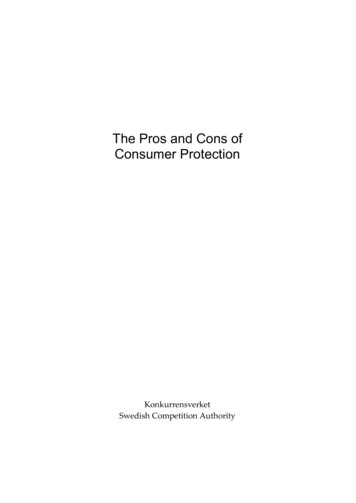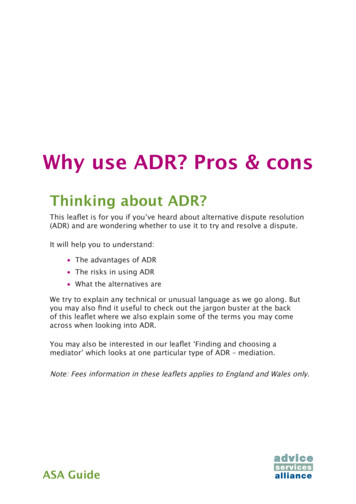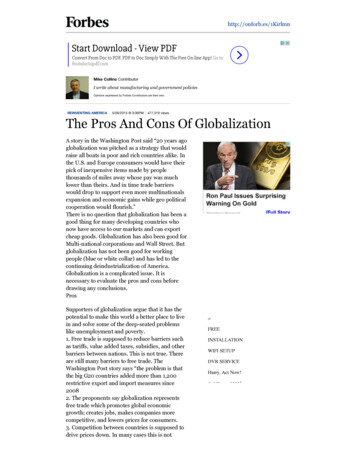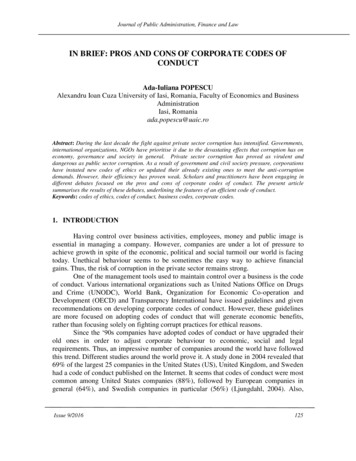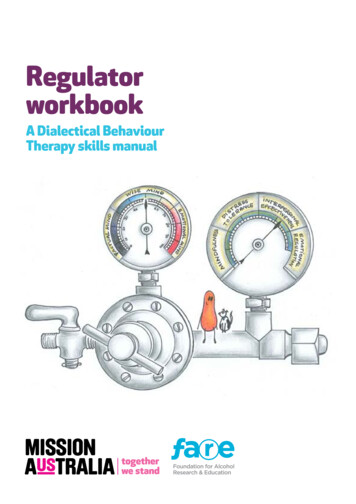
Transcription
Pros and Cons of TETRA vs. P25and theBenefits of a Multi-technology Platformfor TETRA, P25 Phase I / Phase II,and Mobile WiMaxKeith AmmonsVice President, Product Marketing
Pros and Cons of TETRA vs. P25 TETRAo What is TETRA? P25o P25 Phase I / Phase II Comparisono Similarities and differences
What is TETRA? TETRA (Terrestrial Trunked Radio) is an open standardfor digital mobile radio communication defined by ETSI(European Telecommunications Standards Institute). Originally conceived and developed for use by EuropeanUnion government and public safety agencies. Lateradopted as the worldwide “de facto” standard, except NorthAmerica, for digital radio communications systems. Provides a high-end solution for small private systems up tolarge public networks, while preserving characteristics andadvantages of private land mobile radio systems, such asfast call set-up, group calls, and direct modecommunication (talkaround).
TETRA Standard Elements and InterfacesAI - Air Interface (Trunked Mode)DMO - Direct Mode OperationPEIISI - Inter-System InterfaceMSLS - Line Station (dispatcher)TELSC - Local Switching ControllerMMI - Man Machine InterfaceMS - Mobile StationNMS - Network Management SystemLSPEI - Peripheral Equipment InterfaceSBS - Site Base StationSCN - Switching Control NodeSwMI - Switching and Management InfrastructureTE - Terminal BSSwMIGATEWAYTETRA Networknon-TETRANetworkREMOTEDISPATCHERLSC
TETRA General ConceptsTDMA (Time Division Multiple Access) Each RF carrier (radio channel) is divided intotimeslots within a 25 KHz channel. The transmission rate is 7.2 Kbps per slot.7.2 Kbps28.8Kbps36 Kbps
TETRA General ConceptsExample of channel distributionSBS 1T1T2T3T4Carrier 1 MCCH TCH(main)T1 T2PDCHPDCHT3T4Carrier 2 TCHTCHTCHTCHSBS 2T1T2Carrier 1 MCCH SCCHSBS 3T1Carrier 1(main)MCCHCarrier CH
TETRA Highlights High Quality and High Security in communications. Double spectral efficiency. Higher data bandwidths (up to 28.8 kbps) Multiple real-time data services (status, short data,circuit mode data, packet mode data). Half-duplex and full-duplex communications. Interoperable with other networks (TETRA, ISDN, IP, GSM). Continuous coverage. Emergency calls. Fast call setup. Simultaneous voice and data. Open standard technology: protects investment.Total 2258 contracts across 105 countriesData provided by the TETRA Association Members.(October 2008 – latest data available )
P25: Background Project 25 (P25) is a set of standards produced throughthe joint efforts of the Association of Public SafetyCommunications Officials International (APCO), theNational Association of State TelecommunicationsDirectors (NASTD), selected Federal Agencies and theNational Communications System (NCS), andstandardized under the Telecommunications IndustryAssociation (TIA). P25 is an open architecture, user-driven suite of systemstandards that define digital radio communicationssystem architectures capable of serving the needs ofPublic Safety and Government organizations. The P25 standard exists in the public domain, allowingany manufacturer to produce a P25 compatible radioproduct.
P25: Background P25 is defined for two different working modes:o Conventional: provides a simple infrastructure systemthat normally repeat radio calls from one frequency toanother.o Trunked: a controller inside the infrastructure providesintelligence to manage call set up, subscribers roamingacross the system, channel assignment, Additionally, P25 conventional and trunked systems can bedeployed in three different ways according to frequencyusage:o Multicast: All adjacent repeater sites use differentfrequencieso Voting system: All adjacent repeater sites use differenttransmitting frequencies but the same receptionfrequencyo Simulcast: All repeater sites use same Tx/Rx freqs.
P25 Phase I FDMA (Frequency Division Multiple Access) 12.5 KHz channels C4FM (Constant-envelope 4-level FM) Subscribers are backward compatible with analog radiosregardless of the infrastructure. Repeaters can work in analog(not mandatory), digital or mixed mode.
P25 Phase II Phase II: Will be a 6.25 KHz equivalent system, meaning that 1voice communication will fit within 6.25 KHz of channel bandwidth. For the above, P25 Phase II will use a 2-timeslot TDMA structurein 12.5 KHz channels. Control channels will support FDMA for backward compatibilitywith Phase I.
TETRA / P25 ComparisonUseful TETRA - P25 associations: NAC code in P25 is equivalent to MCC and MNC of TETRA TGID (Talk group ID) is equal to GSSI of TETRA UID (Unit ID) is equivalent to ISSI of TETRA ISSI (Inter Sub-System Interface) is equivalent to ISI ofTETRA OTAR in P25 is the same as OTAK in TETRA as it is usedfor E2EE (OTAR in TETRA is used for Air InterfaceEncryption) Pre-programmed messages in P25 is the same as Statusmessages in TETRA. ESN (Electronic Serial Number) is equal to TETRA’s TEI
TETRA Pros and Cons Pros:o Optimized for high population density areaso Spectral efficiency (4 time slots in 25 KHz)o Data bandwidth on demand (up to 28.8 kbps)o RX diversityo Supports full duplex voiceo Short data / status messagingo Packet data / circuit mode data Cons:o Not presently available in VHF bando No simulcast
P25 Pros and Cons Pros:o Optimized for wider area coverage with lowpopulation densityo Greater range than TETRA in Phase I (FDMA),but nearly same in Phase II (TDMA)o Support for simulcast Cons:o Limited data supporto Delays in Phase II standard (projected 2011)
TETRA / P25 Comparison Both technologies are valid solutions for modernprofessional-use digital radio communications systemsOFFERS BOTH SOLUTIONS !
Benefits of a Multi-technology Platform forTETRA, P25 Phase I / Phase II,and Mobile WiMax Common Architectureo Support for TETRA, P25, and WiMax protocolso Interconnectivityo Common Computer Aided Dispatch (CAD) application Benefits / Applications by Sectoro For Transporto For Utilitieso For PSS
Complete Ethernet / IP Architecturea) Distributed switchingb) Distributed intelligencec) No need for GPS or externalsynchronizationFlexibleEasy& Friendly
Common Architecture Field-proven end-to-end IP design. Same network control and management structure for TETRA, P25,and Mobile WiMax. Optimized voice packets reduce delays and lower link bandwidthrequirements. Designed for interoperability. Easy scalability from single site to state-wide networks.
Common HardwareNMS serverRF Base Station/RepeaterLocal Site Controller (LSC)NMS ClientMaster SiteControllerDispatching Console
PowerTrunk RF Unit / BSR The PowerTrunk RF Unit (RFU) / Base Station Repeater (BSR) ismodular and easy to maintain and deploy.o Each module is plug-and-play containing different functional blocksand providing specific alarms to minimize in-the-field repair time.o Designed to be future-proof, it contains all necessary hardware tosupport FDMA structure for P25 Phase I, as well as TDMA structurefor a P25 Phase II or TETRA system.o Software-only upgradeable to P25 Phase II.o Can work in P25 conventional and trunked mode.o Designed to tolerate high delays and jitter in the backbone linkswith the Master Sites (including for satellite links).
TETRA BSR Frequency bands: 350-370, 380-430, 450-470, 806-870 MHzChannel spacing: 25KHz.Time Division Multiple Access (TDMA): 4 timeslots per RF channelModulation: p/4-DQPSKDigital Data Bit Rate: 28.8 Kbits/s.Ethernet interface: IEEE 802.3u,x.RF Unit is hot-swap capable.
PowerTrunk25 RFU Frequency bands: VHF, 380-512 (*), 764-806, 806-870 MHz.(* consult for specific sub-bands) Channel spacing: 6.25KHz, 12.5KHz or 25KHz. Frequency Division Multiple Access (FDMA): 1 channel perRFU Modulation: Digital C4FM. Emissions Designator: 8K10F1W. Digital Data Bit Rate: 9.6 Kbits/s. Ethernet interface: IEEE 802.3u,x. RF Unit is hot-swap capable.
Mobile WiMax RFU Standard: 802.16e (Mobile WiMax)Frequency bands: Initially for 700 MHz band.Channel bandwidth: from 1.25 to 10 MHzDigital Data Bit Rate: from 100 kbps up to 4 Mbps per user
Broadband Performance This is not narrow or wide band, this is broadband:oooMean typical data rate: 1Mbps / userPeak data rate: up to 4 Mbps / userData rate can be managed dynamically Broadband provides the best capability to support the mostdemanding applications:ooooooooooVideo surveillance: remote monitoring for security and safetyVideo recording and streaming on demandRemote data base managementMobile office: staff working at remote locations oron-board vehiclesRemote maintenance of terminals and systemsWeb applicationsTelemedicine, E-healthBiometrics, face recognition.Automation and controlSmart metering
MVC-6000: System ElementsVehicular PCWireless broadbandantennaVehicular videocamerasVHF / UHFradio antennaBroadband TETRA / P25radio terminalAudiointerfaces
Flexibility in the Backbone NetworkSynchronous Links: several types of links (V.35, E1 / T1, ISDN, )SBSSynchronous LinksE1 Drop-InsertG.703/G.704[E1 / T1]E1 / T1ConnectionPDH or SDH SYSTEME1 Cross-ConnectSBSSCNISDN ConnectionV.35 ConnectionV.35 LinkSBSISDN NetworkBRI - PRI[ISDN]ISDN Connection(dedicated BRI)
Flexibility in the Backbone NetworkAsynchronous Links – Layer 2: LAN, WAN, Wi-Fi, WiMAX, LAYER2 SYSTEM ACCESS:: Ethernet connections: Wireless Connections: Optical Fiber ConnectionsSBSSBSSCNWiFiConnectionStandard Office Local AreaNetworkSBSEthernet switchesOptical FiberFiberAccess70 KmEthernet switchFiberAccess
Flexibility in the Backbone NetworkAsynchronous Links – Layer 3: IP Networks, MPLS, L2TPv3, IRB, uterSCNLayer 3 ServicesLayer 3 & Layer 2 ServicesNetwork ServicesSBS
P25 ISSI Inter-RF Sub-System Interface IP connection by VPN established between PowerTrunk and Motorola P25systems to allow group call and emergency call communication by users ofdifferent networks. EADS, Harris, Tait, Raytheon, and Etherstack also participated in the tests. Demonstrates adherence to standards and capacity of interconnection to 3rdparty P25 networks.
CeCoCo SeriesComputer Aided Dispatch Solutions
CeCoCo Includes modules for communicationmanagement, location, and incidentmanagement Ethernet-based connection with thePowerTrunk range of TETRA and P25infrastructure Additional services:o Discreet Listeningo Ambience Listeningo Call inclusion / terminationo Fleet monitoringo Priority callso Emergency callso Pre-emptive PTTo Call Patching
CeCoCo ctureTCP / IPVoIPTETRA & P25Radio InterfacesLegacyConventionalSystemLegacy TrunkedSystemCeCoCo SERVERCall Taker /DispatcherWorkstationPABX / PSTN(E1/T1, ISDN,VoIP, etc.)Connect Switching MatrixCall Taker /DispatcherWorkstationPA systemRecording SystemAnalog Telephony
Entornos ferroviariosTETRA for TransportMetros / SubwaysRailroadsTramsBuses
Transport Communications Requirements Voice communication between drivers, controlcenters, depots, and passengers. Location systems. Data services for remote monitoring of subsystems. Railway signaling. Safety and security. Communication with maintenance crews. Communication with emergency services(police, fire, etc.)
Telecommunications Sub-systemsCovered by TETRAVoiceCommunicationInteractionwith IntercomSystemRemoteCommand andControl ofRolling StockCommunicationManagementSub-systemIntegration withPassengerInformationSystemIntegration withPublic AddressSystems
Examples of Remote Controls and AlarmsREMOTE CONTROL:-Train On / Off-Identification (Train number andservice)-Emergency brakes-Brake bypass / Traction loop-Fire estinguishing system-ALARMS:-Fire detection-Emergency alarms-Emergency brake-Passenger SOS button-End of lineOpen / close doors-End of service-Control of lighting, air conditioning,etc.-“Dead man” alarm-Train location-TCMS configuration/ Driving mode-Intercom failure alarm-Talkgroup selection (by DGNA,according to train location)-P.A. system failure alarm-Information panels-Change of driving mode-Pneumatic suspension-Battery voltage-Etc.-Etc.
Buses & Trams – Optimizing AVL Automatic regulation – Efficiency mostly dependson the refresh period which can be achieved Old analog systems – Control of radio channels(PTT-CD signals) by AVL Applications TETRA TDMA. How to overcome the gapbetween the AVL Application and TETRAtransport layers?
Basic SDS SolutionBased on: Basic TETRA Short Data Service (SDS) for pollingand transmitting GPS position in LIP format.Speed of position polling / reply: The fastest rate is 1 position every 0.6 seconds.Advantage: Supported by the majority of TETRA terminals in themarket.Disadvantages: Care must be taken to poll terminals one by one, otherwisedegraded audio quality could result due to use of theTETRA stealing mechanism. Not appropriate for large networks.
PowerTrunk SDM Solution for AVLSDM (Synchronous Data Manager) is based on: Use of the SDS (LIP) service with reservation of airresources, permitting reception of GPS positions at the basestation while avoiding collisions (synchronization concept). Special software in the infrastructure and the terminals.Speed of polling / reply: The fastest rate is 5 positions per second for each CCH (controlchannel) of the system, whether MCCH or SCCH.Advantages: Acts in parallel for all zones simultaneously. Eliminates collisions in the uplink (synchronous). Efficiency increases with the number of zones. In traffic, GPS positions are sent between PTT change
Transport ScenariosWiMAX: Video surveillance in trainsand station platforms / bulk data transfer in depotsTETRA / WiMAXWiMAX: Video surveillance and otherspecific broadband applications, i.e. cargodetails of ships, etc.TETRA:Voice and short data service for train operationSecurity services in stationsVoice services for maintenance personnelTETRA:Voice and short data service for airport / port operationVoice services for maintenance personnelTETRA / WiMAX
TETRA for Utilities
TETRA for Utilities1. Specific data transmission requirements for: Permanent monitoring and control of the network elements(Telemetry and Remote control) Data bandwith and reliability transmission. High availability. Integration with SCADA applications Goal: To support and improve the level of service to the users.To reduce CAIDI index.2. Growth capacity: To solve saturation problems and overcome limited growthcapability of current communication networks.3.Energy savings: Obtain detailed information about subscriber consumption to allowcustomized tariffs and to avoid peaks of consumption during mostcritical time slots (Smart Grid concept). Goal: Cost reduction.
What does TETRA offer?1. Private Network Total network control without depending on operators.2. Digital trunking system (cellular) Robust communication. Several options for network coverage redundancy If a repeater fails, modems roam and the monitoring system is not interrupted.High spectral efficiency Cost savings.3. Avoids radio collisions in the air TETRA technology solves directly this problem.4. Network Growth capacity / Possibility of additional services (voice,etc.)5. Data services Availability of different data services to be adapted to communication needs: Short Data Messages (SDS) and status messages Standard Packet Data service (PD) Circuit Mode Data (CMD)
PowerTrunk SDM Solution for SCADATime required to manage the generated Keep-alive and alarmsignals for a set of 20 remote units registered in a network of1 Base Station.Example scenario:420 remote units.420 bytes of information.41 SBS.300 Seconds0.5 SecondsOthertechnologiesSynchronousData Manager
Utilities: Smart Grid ScenarioWiMAX:Video surveillanceSmart metering and bulk data transmission forother specific applicationsTETRA:Short Data Services for telemetrySecurity servicesVoice services for maintenance personnelAVL application for vehiclesTETRA / WiMAXIntegrationwith SCADAapplicationsComputerAidedDispatchers
P25 for Public Safety
Public Safety / Communications Requirements Integrated communications system (radio, telephone, VoIP,.) Fast and reliable voice services Data services to improve traditional voice-based operationaltasks No reliance on public based networks (avoid saturation duringemergencies) Minimize TCO (Total Cost of Ownership) by enabling networksharing Interoperability between different Public Safety agencies – openstandard Comprehensive Computer Aided Dispatch for resourcescoordination Vehicle & Personnel location services (GPS) 100 % availability Advanced security mechanisms
P25 Network Elements
CeCoCo ArchitectureIntegration with anemergency numberPermits effective interaction betweendifferent agencies.Coordination of resourcesIncoming emergencycallsof each organizationsPolice NetworkIsolated networksIntegration ofcommunicationsPoliceDispatch911 Call takers andcoordinators for theemergencyFire Dept NetworkFire DeptDispatchCentralized management, singleincident among multiple organizations
MVC-6000 Multi-Bearer Vehicular Console
Public Safety ScenarioOfficial building access:Video surveillanceService assignmentVehicle LocationMedical data(photos, videos,patient history,remote diagnostics)Traffic signal control:Traffic lights, radars,etc.Traffic monitoringP25 / WiMAXIntegrated ComputerAided DispatchersService assignment (photos, video,audio files, map location)Vehicle Location, Navigation mapsMobile officePortal Web accessIncident videoService assignmentVehicle LocationMobile officeIncident videoBuilding floor plans access
Main Customer References
Transport ReferencesSpainGermanyAlicante Light Train, FGV (ETRA, VossloghBombardierNuremburg Metro (T-Systems)Palma de Mallorca Metro (Sampol, CAF)KÖR Buses & Trams (T-Systems)Barcelona Metro Line 9 (Tradia)BrazilBarcelona Buses (TMB)Supervia, Rio de Janeiro RailwayMadrid Metro (CAF, Ansaldo)Brazilia Tramway (ALSTOM)Madrid Light Train T-2, T-3 (ETRA, ALSTOM)Parla Light Train (ALSTOM)RussiaSanta Cruz de Tenerife Light Train (Ikusi UTE,ALSTOM)Moscow – St. Petersburg RailwayBilbao AirportAlgeriaMexicoAlgiers Underground (Siemens)Mexico D.F. Light Train (Alcatel, CAF)Constantine Tramway (EFACEC)Mexico D.F. Metro Line B (ALSTOM)Oran TramwayMexico D.F. Metro Line 2 (ALSTOM)ChileMexico D.F. Metro Line 12 (ALSTOM)Santiago Metro (Siemens)
Transport ReferencesColombiaEmcaliBogota Buses (Transmilenio)MalaysiaTanjung Pelepas Port (J&J – Comintel)France / SwitzerlandTETRA on-board systems for Marseille, Nice,Grenoble, Bordeaux, Geneva, Lausanne,and 10 other French / Swiss cities.
Public Safety ReferencesSpainMexicoItelazpi, Basque CountryFederal District Public Safety Secretariat(Milpa Alta)EXPO ZaragozaZaragoza City Local Police and Fire BrigadesCity of PueblaCordoba City Local PoliceArgentiaCanary Islands Regional GovernmentNeuquen Regional Government (Damovo)Ceuta Regional GovernmentAlcala de Guadaira City Local PoliceColombiaTelefonica Security Engineering (GuadarramaTunnel)Cali Government & Public SafetyBrazilBahia State Public Safety Secretariat (SSP)Rio de Janeiro Public Safety Secretariat(SSP) (Pan-American Games)South KoreaIncheon Metropolitan Police Agency (KDN)
Other ReferencesMining:Operators:Iron and Steel Company, CST ArcelorMittal Tubarao, BrazilLig Mobile, BrazilRio Tinto, AustraliaUtilities:COELCE, BrazilFederal Comission of Electricity -CFE-, MexicoGuadiana Hydrographic Authority (Adasa),SpainSports Stadiums:Real Madrid Football Club, SpainGas & Oil:Repsol YPF (Intepla/Intema), ArgentinaAirwaves, Auckland city TETRAoperator, New ZealandTelefónica Móviles España, SpainOthers:Música Funcional (sistema PAMR), AndorraTelecomunicación Sistematizada, MexicoTorre Picasso (Telvent), SpainDegussa (T-Systems), GermanyChemiepark Bitterfeld, GermanyKVB Köln (T-Systems), GermanyBayerische Rieswasser (T-Systems),GermanyTetra Iceland (Niros), IcelandInformation Industry Company, Russia
Summary / Conclusions
Pros and Cons of TETRA vs. P25 TETRAo What is TETRA? P25: Phase I / Phase II Comparisono Similarities and differencesBenefits of a Multi-technology Platform Common Architecture for TETRA, P25, and WiMax Benefits / Applications by Sectoro For Transporto For Utilitieso For PSS
“One Platform, Multiple Technologies”Desktop Radio DispatcherMobile Unit (in-vehicle)A COMPLETEHand Portable UnitNetwork InfrastructureSOLUTIONTransportable SystemsMobile Unit (Motorbike)Railway On-board EquipmentRadio ModemsCoordination and Control Center
Thank you foryour attention
TETRA / P25 Comparison . . o Software-only upgradeable to P25 Phase II. o Can work in P25 conventional and trunked mode. . o Automation and control o Smart metering . Broadband Performance . Vehicular PC . Broadband TETRA / P25 radio terminal . VHF / UHF radio antenna

